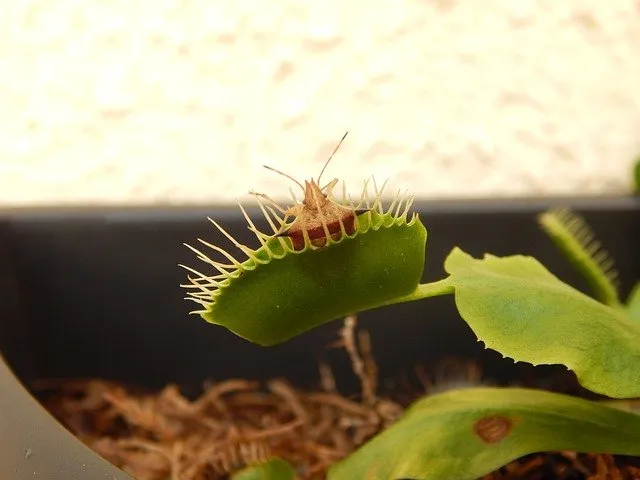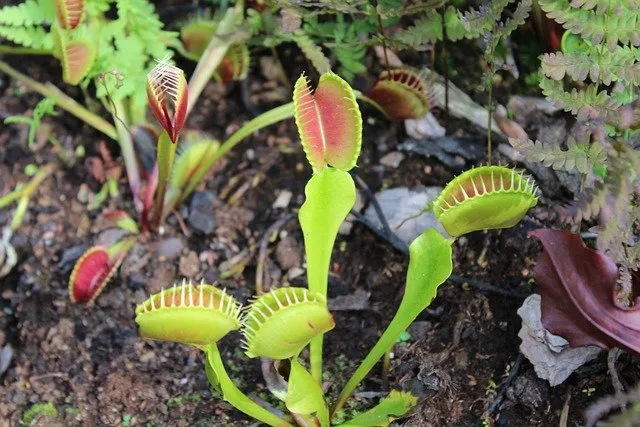As an Amazon Associate I earn from qualifying purchases.
In the world of botanical wonders, few plants capture our imagination quite like the Venus flytrap. With their snapping jaws, these carnivorous marvels have fascinated scientists and nature enthusiasts for generations. If you’ve ever pondered the intriguing question, “What do Venus flytraps eat?” you’re in the right place.
In this comprehensive blog, we will explore the intricate dietary habits of Venus flytraps, dissecting the details of their carnivorous cravings and shedding light on the remarkable adaptations that allow them to thrive in nutrient-scarce environments. So, buckle up as we embark on a journey into the captivating world of these insect-eating wonders!
Understanding Venus Flytraps
Before diving into their diet, let’s briefly understand the anatomy and behavior of Venus flytraps. These plants are native to the subtropical wetlands of the Southeastern United States, primarily North and South Carolina. Venus flytraps have distinct features, including a rosette of green leaves with hinged traps that can snap shut when triggered. Each trap contains tiny trigger hairs on the inner surface. The trap rapidly closes when an insect touches these hairs multiple times, capturing the prey.Now, let’s explore the various foods Venus flytraps consume:
1. Insects
The primary source of nutrition for Venus flytraps is insects. These plants are adapted to nutrient-poor environments, so they have evolved to capture and digest insects to supplement their diet. The types of insects they consume include:
Flies: Common house flies, and fruit flies are frequent visitors to Venus flytrap traps. Their small size makes them easy prey.
Ants: Venus flytraps can also capture ants, although they are slightly larger than flies. Ants are often lured into the traps by the plant’s sweet nectar.
Beetles: Some Venus flytrap varieties can catch larger insects like beetles. The traps of these varieties are larger and more robust.
Spiders: Occasionally, Venus flytraps may catch tiny spiders. While not their primary food source, spiders can become trapped if they venture into the traps.
2. Other Arthropods
In addition to insects, Venus flytraps can capture other small arthropods, like tiny mites that crawl into the traps and can become prey for Venus flytraps. These microorganisms provide supplementary nutrients.
3. Digestion Process
Once an insect or arthropod is trapped, the Venus flytrap begins digestion. The inner surface of the trap secretes digestive enzymes that break down the prey’s soft tissues, turning them into a nutrient-rich slurry. This process can take several days to complete.
4. Absorption of Nutrients
After digestion, the Venus flytrap absorbs the nutrients, including nitrogen and phosphorus, from the dissolved prey. These nutrients are vital for the plant’s growth and development.
5. Avoidance of Non-Food Items
It’s important to note that Venus flytraps have mechanisms to prevent the consumption of non-food items. The traps will only close if the trigger hairs are stimulated multiple times in quick succession, ensuring that only living organisms trigger the capture.
How To Feed Pet Venus Flytraps?
Feeding your pet Venus flytrap is a crucial aspect of its care, as it helps supplement their nutrient intake, especially when they are grown indoors or in environments with limited access to insects. Here’s a step-by-step guide on how to feed your pet Venus flytrap:
Materials Needed:
- Live insects (e.g., flies, ants, small beetles, or other suitable prey)
- Small tweezers or forceps
- A pair of small scissors (optional)
- Distilled or rainwater for watering
- Steps to Feed Your Venus Flytrap:
1. Select the Right Prey:
Choose live insects that are small enough to fit entirely inside the trap. Houseflies, fruit flies, and ants are common choices. The prey should be healthy and active, triggering the trap more effectively.
2. Prepare the Prey:
If the insects you’ve selected are too large or active, you can immobilize them slightly. Gently pinch or cut off the legs or wings of the insect using small scissors or tweezers. Be careful not to damage the main body of the insect.
3. Choose a Trap:
Venus flytraps have several traps; not all may be ready to capture prey. Select a trap that is open and appears healthy. Avoid traps that are already closed, as they are likely digesting prey.
4. Hold the Prey:
Use small tweezers or forceps to hold the prepared insect near the trap’s center. Position the prey to touch the trigger hairs inside the trap. This is essential to initiate the trap’s closing mechanism.
5. Trigger the Trap:
Gently stimulate the trigger hairs inside the trap by touching them with the insect. The trap will respond by quickly closing around the prey. Ensure that the entire insect is inside the trap.
5. Avoid Overstimulation:
Do not repeatedly touch the trigger hairs or disturb the trap excessively, as this can exhaust the plant’s energy and reduce its ability to capture more prey.
6. Provide Adequate Light:
After feeding, place your Venus flytrap in a location with bright, indirect sunlight or partial shade. Adequate light is essential for the plant to effectively process and digest the prey.
7. Water Properly:
Always use distilled or rainwater when watering your Venus flytrap. Avoid tap water, as it contains minerals that can harm the plant. Water the plant by placing the pot in a tray of water and allowing it to soak for about 30 minutes, then remove it from the water tray.
8. Wait for Digestion:
The digestion process can take several days to a couple of weeks, depending on the size of the prey and environmental conditions. The trap will gradually reopen as the plant absorbs nutrients from the digested prey.
9. Monitor and Maintain:
Keep an eye on your Venus flytrap to ensure that the trap has fully reopened and is ready to capture new prey. Continue to feed your plant occasionally, following the same steps, to ensure it receives adequate nutrition.
How Do Venus Flytraps Help Our Environment?
Venus flytraps, though small and seemingly inconspicuous, play a significant role in their natural environment and can have several positive impacts on the ecosystem:
1. Pest Control:
Venus flytraps are nature’s pest controllers. By capturing and consuming insects, they help regulate insect populations in their habitat. This natural pest control can benefit the surrounding flora by reducing herbivorous insect damage. In this way, Venus flytraps contribute to the overall health of their ecosystem.
2. Nitrogen Recycling:
Venus flytraps grow in nutrient-poor, acidic soils with limited essential nutrients like nitrogen. They have evolved their predatory behavior to supplement their nutrient intake. By absorbing nitrogen from their prey, Venus flytraps effectively recycle nutrients within their ecosystem. This recycling process helps maintain the balance of nutrients in the soil, benefiting other nearby plants that may not have access to such resources.
3. Habitat for Other Species:
The micro-ecosystem within Venus flytrap traps can support a variety of tiny organisms, including bacteria and fungi. These microorganisms help break down the prey and aid in nutrient absorption. These microhabitats become homes and food sources for other organisms, such as mites, springtails, and small nematodes. These interactions contribute to the overall biodiversity of the Venus flytrap’s habitat.
4. Education and Conservation:
Venus flytraps serve as powerful educational tools. Their unique characteristics and carnivorous behavior captivate the interest of students and nature enthusiasts, fostering an appreciation for biodiversity and plant adaptations. This increased awareness can lead to greater conservation efforts to protect Venus flytraps and their native habitats, which are increasingly threatened by habitat destruction and poaching.
5. Carbon Sequestration:
As with all plants, Venus flytraps play a role in carbon sequestration. They absorb carbon dioxide from the atmosphere during photosynthesis and convert it into organic matter. While Venus flytraps may not be as efficient as some larger trees in sequestering carbon, every contribution to reducing atmospheric carbon levels benefits the fight against climate change.
6. Research and Scientific Insights:
Venus flytraps continue to be subjects of scientific research and study. Their unique adaptations have inspired scientists to delve into areas of plant biology, genetics, and biomechanics. Insights gained from studying Venus flytraps can have broader implications for understanding plant behavior and evolutionary adaptations.
Final Words
In conclusion, the mystery behind “What do Venus flytraps eat?” has been unraveled, revealing the fascinating world of these carnivorous wonders. As we’ve explored their dietary habits and the types of prey they consume, it’s clear that these unique plants are nature’s pest controllers, contributing to ecosystem balance, nutrient recycling and even inspiring a deeper understanding of the natural world. Whether you’re a seasoned enthusiast or a curious beginner, understanding the dietary needs of Venus flytraps is essential for their well-being. So, the next time you marvel at the snap of a trap, you’ll appreciate these remarkable plants’ role in their environments, reminding us of the intricate web of life surrounding us.
You can also read:
1.What Do Silverback Gorillas Eat? The Diet of Silverback Gorillas
2.What Do Painted Lady Butterflies Eat? From Caterpillar to Butterfly
3.A Lovebird’s Culinary Delight: What Do Lovebirds Eat?
4.What Do House Wrens Eat? Insectivores of the Garden
Amazon and the Amazon logo are trademarks of Amazon.com, Inc, or its affiliates.




